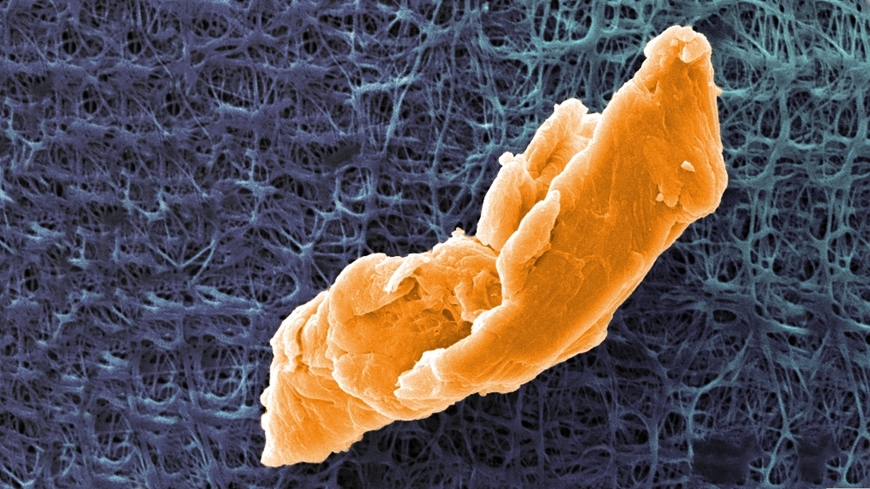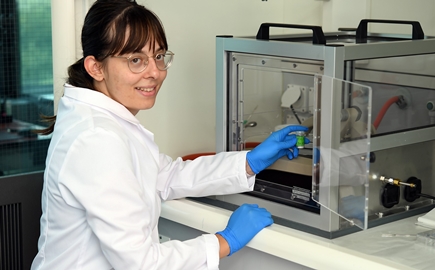Environmental research
How dangerous are nanoplastics for babies in the womb?
Allergies and asthma are widespread diseases that could arise during embryonal development in the womb. A team led by Empa researcher Tina Bürki is investigating the possible causes of this. The focus is on nanoplastic particles, which could lead to the development of a hypersensitive immune system in the child. The project is supported by the Eduard Aeberhardt Foundation and another foundation.

Asthma, hay fever or chronic skin conditions: The occurrence of allergic reactions is diverse and on the rise. Among other things, environmental factors during the child's early development in the womb are suspected, which lay the foundation for later illnesses. A team of researchers from Empa, ETH Zurich, EPFL, the University of Zurich and the Cantonal Hospital of St. Gallen is now focusing on micro- and nanoplastics. It is already known that the tiny plastic particles enter the body of pregnant women via drinking water, food and air and find their way to the unborn child. Here they could affect the fragile immune system of mother and child. Moreover, they are able to transport other pollutants, allergens and pathogens.
The new research project now aims to provide a holistic view of the significance of plastic particles during pregnancy. To achieve this, experts from the fields of materials science, cell biology and allergy research are working together with clinical experts. The project is funded by the Eduard Aeberhardt Foundation and another foundation.
Correctly assessing the risk

The team led by project manager Tina Bürki and Sina Ruhstaller from Empa's Particles-Biology Interactions laboratory in St. Gallen are particularly interested in the placenta, the central interface between mother and child. The organ forms exclusively during pregnancy and supplies the child with nutrients and messenger substances for a healthy development. The placenta could therefore play a decisive role when it comes to the immune response of mother and child to foreign substances.
It is already clear that nanoparticles can disrupt the communication between the placenta and the unborn child. However, the effect of micro- and nanoplastics on the immunological function of the placenta and the effects on the fetal immune system have not yet been elucidated. "There is thus an urgent need for a correct risk assessments of environmental pollutants for pregnant women," says Bürki.
In order to analyze the entire process of nanoparticle exposure, the researchers will examine the micro- and nano-abrasion of everyday plastic products and evaluate the interactions with typical allergy-causing substances and pollutants. Finally, using cell cultures of the human placenta and fetal blood cells, the transport in the body and the reaction to the various particles and pollutant-particle combinations can be mapped as realistically as possible. "By releasing hormones and other mediators, the contaminated placenta could contribute to abnormal developments in the child's immune system," says Tina Bürki. For the sustainable use of safe plastic products, it is therefore essential to know whether and which polymers have an increased potential to trigger allergies, says the Empa researcher.
Private support that makes the difference
Thanks to generous donations from the Eduard Aeberhardt Foundation and another foundation, the project could get started. However, further funds are still being sought. The Empa Zukunftsfonds is looking for private funding for pioneering research projects that are not yet (fully) supported. If you would also like to make a contribution to the project, you can find our donation form here.
Dr. Tina Bürki
Particles-Biology Interactions
Phone +41 58 765 7696
Loris Pandiani
Empa Zukunftsfonds
Phone +41 58 765 47 03
Technology transfer
How do innovations get out of the lab and into the wider world? There are different ways, summarized under the term technology transfer. At Empa, technology transfer takes many different forms – be it through direct industry cooperation, Innosuisse-funded projects or by founding start-ups. If these endeavours are ultimately successful, they result in innovative products and solutions that make our world a little bit better.
Read the latest EmpaQuarterly online or download the PDF version.
-
Share






